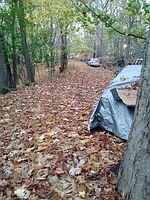Ghost Roads: The Carriage Path
Before there was a Palisades Parkway, before there were neighborhoods called Indian Hill or Palisades Gardens, in the 1920s there was a large estate that lay between Oak Tree Road, Closter Road, and Route 340, owned by Charles Nessler, the man who invented the permanent wave. This estate is remembered now chiefly because of the strange, Daliesque architecture of the house he built on it, and his herd of fallow deer. The estate also abutted the property of Nicholas Gesner who lived on Closter Road next to the New Jersey border and who had constructed a lane that went through his farm from Closter Road to Route 340. This lane was at one time known as “Gesner’s Lane” but for Robert Guttman and the other children growing up in the Indian Hill subdivision of the Nessler estate, the lane was known as “the carriage path” for reasons now long forgotten.
After Bob read the most recent Ghost Roads article in this past October’s issue of 10964, he contacted the newsletter to alert us to a ghost road he was sure we would know nothing about. I asked him to take me there. We met at the top of Indian Hill Lane on a cool, clear day and walked through the fallen leaves into the woods behind his mother’s house. He’s right. If you’ve never been to Bob’s childhood home, you would never know about this lane. He pointed out a gully that to my untrained eye seemed unremarkable but to his knowing one revealed the remnants of carriage tracks. The wild part of the path dipped steeply to the left along a small cliff where it widened to serve its current function as a driveway to a house hidden in the trees.
As it turns out, the carriage path is not so much lost as repurposed. It’s true, some of it is now buried under the Palisades Parkway embankment, truly lost, and the middle section is reverting to the wild, but Bob showed me the two remaining ends that are still in constant use, one as a driveway to a house on Horne Tooke Road in Palisades and the other as the paved road in Rockleigh, New Jersey called Piermont Road E. “We used to sled down this thing, if you can believe it. All the way to New Jersey.” He chuckled, New Jersey being of course just yards away.
He went on to say that the adults drove their cars on the path, using it as an actual road, a shortcut to Oak Tree Road. Back in the day when Bob was a paperboy, he biked down the path to his customers on Oak Tree Road and on Route 340.
When the snow melted, he and his friends played games of adventure there. They told each other stories about the wild animals that used to be kept there in a kind of zoo, all manner of exotic creatures the old rich man who used to own the land supposedly kept. They didn’t know if the stories were true but they were deliciously thrilling, as if some surviving beast, maybe a tiger or an elephant, a ghostly beast, still roamed the woods, hungry, unsatisfied, and might at any time emerge onto the long lost carriage path, to spook them as they imagined the ghosts of Indians haunting the houses built over their graves.
I was suddenly uncomfortable listening to these childhood tales. I could almost feel the old Gesner’s Lane shifting uncomfortably under the weight of asphalt, suffocating under the parkway, and sighing an extinguishing sigh as it sunk into a wooded gully, into oblivion, with no one to remember.


